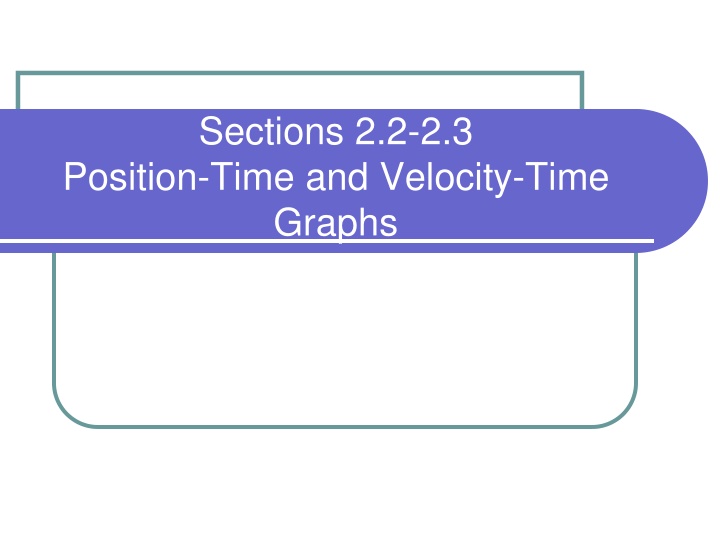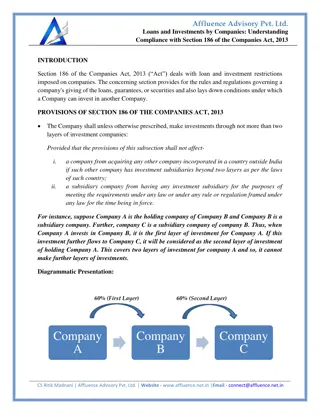
Position-Time and Velocity-Time Graphs in Physics
Explore the characteristics of position-time graphs, including constant speed, rest, acceleration, deceleration, and velocity translation. Understand how features on one graph correlate to features on another for effective analysis in physics.
Download Presentation

Please find below an Image/Link to download the presentation.
The content on the website is provided AS IS for your information and personal use only. It may not be sold, licensed, or shared on other websites without obtaining consent from the author. If you encounter any issues during the download, it is possible that the publisher has removed the file from their server.
You are allowed to download the files provided on this website for personal or commercial use, subject to the condition that they are used lawfully. All files are the property of their respective owners.
The content on the website is provided AS IS for your information and personal use only. It may not be sold, licensed, or shared on other websites without obtaining consent from the author.
E N D
Presentation Transcript
Sections 2.2-2.3 Position-Time and Velocity-Time Graphs
Questions for Consideration What is a position-time graph from Unit 1? What is a velocity-time graph? How do features on one graph translate into features on the other?
Position-Time Graphs Show an object s position as a function of time. x-axis: time y-axis: position
Position-Time Graphs What are the characteristics of this graph? Straight line, upward slope What kind of motion created this graph? Constant speed 10 9 8 7 6 position (cm) 5 4 3 2 1 time (s) 1 2 3 4 5 6 7 9 10 8
Position-Time Graphs Each type of motion has a characteristic shape on a P-T graph. Constant speed Zero speed (at rest) Accelerating (speeding up) Decelerating (slowing down)
Position-Time Graphs Constant speed is represented by a sloped, straight segment on the P-T graph. pos. (m) pos. (m) time (s) time (s) Constant speed in positive direction. Constant speed in negative direction.
Position-Time Graphs A horizontal segment means the object is at rest. pos. (m) time (s)
Position-Time Graphs Curved segments that get steeper on the P-T graph mean the object s speeding up pos. (m) pos. (m) time (s) time (s) Speeding up in positive direction. Speeding up in negative direction.
Position-Time Graphs Curved segments that level off on the P- T graph mean the object s slowing down pos. (m) pos. (m) time (s) time (s) Traveling in positive direction but slowing down. Traveling in negative direction but slowing down.
Position-Time Graphs The slope of a P-T graph is equal to the object s velocity in that segment. change in y change in x slope = 50 position (m) 40 (30 m 10 m) (30 s 0 s) 30 slope = 20 (20 m) (30 s) 10 slope = 10 20 30 40 time (s) slope = 0.67 m/s
Position-Time Graphs The following P-T graph corresponds to an object moving back and forth along a straight path. Can you describe its movement based on the graph? N position (m) time (s) S
Velocity-Time Graphs A velocity-time (V-T) graph shows an object s velocity as a function of time. A horizontal line = constant velocity. A straight sloped line = constant acceleration. Acceleration = change in velocity over time. Positive slope = positive acceleration. Not necessarily speeding up! Negative slope = negative acceleration. Not necessarily slowing down!
Velocity-Time Graphs A horizontal line on the V-T graph means constant velocity. + Object is moving at a constant velocity in the + direction velocity (m/s) time (s) -
Velocity-Time Graphs A horizontal line on the V-T graph means constant velocity. + Object is moving at a constant velocity in - direction velocity (m/s) time (s) -
Velocity-Time Graphs If an object isn t moving, its velocity is zero. + Object is at rest velocity (m/s) time (s) -
Velocity-Time Graphs If the V-T line has a positive slope, the object is undergoing acceleration in positive direction. If v is in positive quadrant, object is speeding up. If v is in negative quadrant, object is slowing down.
Velocity-Time Graphs V-T graph has positive slope. + + velocity (m/s) velocity (m/s) time (s) time (s) Negative velocity and positive slope,: object is slowing down. Positive velocity and positive slope: object is speeding up! - -
Velocity-Time Graphs If the V-T line has a negative slope, the object is undergoing acceleration in the negative direction. If v is positive, the object is slowing down. If v is negative also, the object is speeding up.
Velocity-Time Graphs V-T graph has negative slope. + + velocity (m/s) velocity (m/s) time (s) time (s) Negative velocity and negative acceleration: object is speeding up! (in negative direction) Positive velocity and negative acceleration: object is slowing down, - -
Assignment Worksheets on P-T and V-T graphs






















